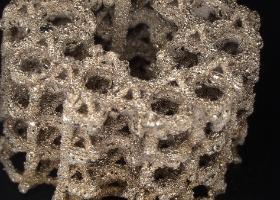
3D printed silver implants help tackle infections
An interdisciplinary team of researchers from the University of Wolverhampton and the University of Sussex are investigating the possibility of 3D printing patient-specific silver- based implants to reduce infection and antimicrobial resistance.

Despite substantial advances in invasive surgery and aseptic techniques, implant-related infection remains an all too common complication.
The team, Dr Arun Arjunan, John Robinson, Dr Enas Al Ani, Dr Wayne Heaselgrave, Dr Ahmad Baroutaji and Dr Chang Wang, reported that 3D printed silver implants and tissue engineering scaffolds provides antibacterial protection, while featuring complex porous architecture, suitable for patient-specific tissue reconstruction.
Dr Arun Arjunan, Reader in Additive Manufacturing of Functional Materials at the University of Wolverhampton, said: “Millions of people across the world suffer from inflammatory and degenerative diseases associated with bone and joints requiring implants where infection is a serious complication resulting in pain, mortality, prolonged recovery, and antimicrobial resistance. Therefore, reducing the risk of infection associated with tissue implants requires imminent attention, where pure silver offers enormous potential.
“Although the idea of using silver as an antibacterial agent is not necessarily new, this research is the first step towards developing 3D printed silver based infection resistant porous implants.
“3D printing patient-specific implants featuring silver is challenging due to the high laser energy dissipation, reflection and complex thermo-mechanical behaviour. Additionally, the printability, mechanical performance and microbial resistance of 3D printed silver have not yet been explored.”
In the study, the team fabricated 99.9 per cent pure-silver through selective laser melting, which is the 3D printing technique employing laser energy to melt and fuse metallic powders. The properties of the resulting silver and two fully porous bone scaffolds were investigated to assess the suitability for tissue engineering.
The antimicrobial efficacy of printed silver was tested against the common implant infection-causing Staphylococcus aureus and led to 90 per cent kill in four hours and 99.9 per cent in 14 hours. The study also shows that 3D printed pure silver scaffolds can be used as a cancellous bone replacement as they offer comparable strength.
Dr Arjunan added: “While the 3D printed pure silver implants might not offer the required structural strength for replacing cortical bone, it can lend itself to the development of hybrid implants that offer antibacterial efficacy without secondary post-processing."
“This not only reduces the cost of developing fully porous antibacterial bone scaffolds but also accelerates the bench-to-bedside development of patient-specific antibacterial implants,” said Dr Wang from the University of Sussex. “Though there are many remaining challenges, reducing the use of antibiotics through the development of multifunctional implants is the future of bone reconstruction”.
The findings of this study will serve as the basis for the development of new functional silver-based biomaterial and alloys suitable for infection-resistant total-bone replacement, reducing the reliance on antibiotics and improving patient recovery.
The full study can be accessed at https://doi.org/10.1016/j.jmbbm.2020.104090
For more information please contact the Corporate Communications Team.


/prod01/wlvacuk/media/departments/digital-content-and-communications/images-18-19/iStock-163641275.jpg)
/prod01/wlvacuk/media/departments/digital-content-and-communications/images-2024/250630-SciFest-1-group-photo-resized-800x450.png)
/prod01/wlvacuk/media/departments/digital-content-and-communications/images-18-19/210818-Iza-and-Mattia-Resized.jpg)
/prod01/wlvacuk/media/departments/digital-content-and-communications/images/Maria-Serria-(teaser-image).jpg)
/prod01/wlvacuk/media/departments/digital-content-and-communications/images-2024/241014-Cyber4ME-Project-Resized.jpg)
/prod01/wlvacuk/media/departments/digital-content-and-communications/images-18-19/210705-bric_LAND_ATTIC_v2_resized.jpg)

